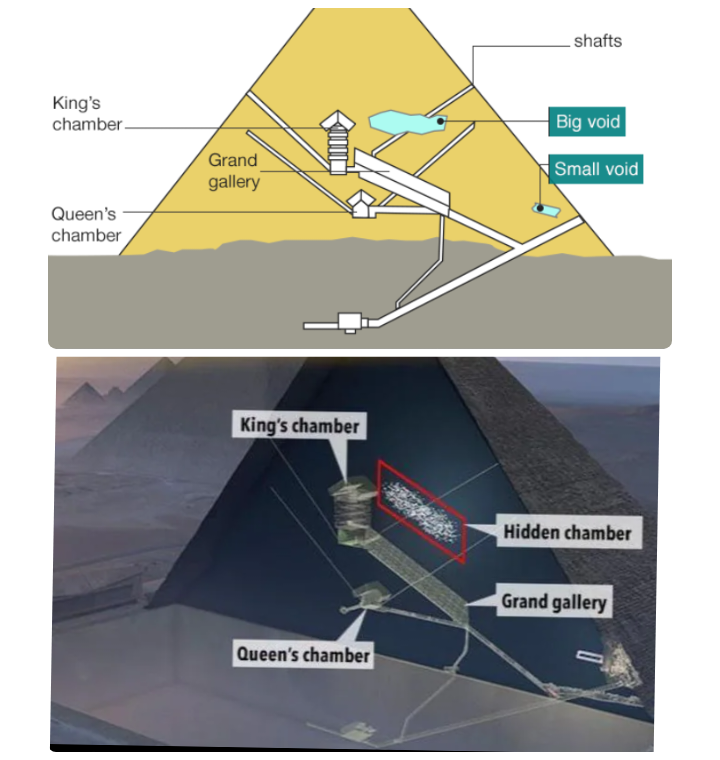In recent years, several notable discoveries of hidden chambers within Egyptian pyramids, excluding the Great Pyramid of Giza, have been made. These findings provide deeper insights into ancient Egyptian architecture and burial practices.
Hidden Rooms in Sahura’s Pyramid:
In October 2023, archaeologists uncovered previously unknown rooms within the Pyramid of Sahura, located in the Abusir necropolis.
Built over 4,400 years ago for Pharaoh Sahura of the Fifth Dynasty, this pyramid had been initially explored in 1836 by Egyptologist John Perring. However, recent investigations revealed hidden chambers that had eluded earlier explorers.
These newly discovered rooms are expected to shed light on the reign of Pharaoh Sahura and the architectural innovations of that period.
Discovery of a Pyramid in Dahshur:
In February 2025, archaeologists made a significant discovery in the Dahshur necropolis, south of Cairo.
While excavating beneath a local quarry, they uncovered finely cut limestone blocks leading to the remains of a pyramid hidden under the sands for thousands of years.
This previously unknown pyramid offers new opportunities to study the architectural styles and burial customs of ancient Egyptian royalty.
Uncovering a Hidden Chamber in the Sphinx:
Recent explorations have also led to the discovery of a hidden chamber within the Great Sphinx of Giza.
This finding has sparked discussions among Egyptologists about the potential purposes of such chambers, ranging from storage rooms to ceremonial spaces.
The discovery adds another layer of mystery to the already enigmatic Sphinx, prompting further studies to understand its full significance.
These discoveries underscore the importance of continuous exploration and technological advancement in archaeology.
As non-invasive scanning techniques improve, they allow researchers to uncover hidden aspects of ancient structures without causing damage, leading to a more comprehensive understanding of Egypt’s rich historical and cultural heritage.
In recent years, significant discoveries have been made within the Great Pyramid of Giza, shedding new light on its internal architecture and construction methods.
Discovery of the 9-Meter-Long Corridor (2023):
In March 2023, Egyptian antiquities authorities unveiled a previously unknown corridor inside the Great Pyramid, also known as Khufu’s Pyramid.
This corridor, measuring approximately 9 meters (30 feet) in length and over 2 meters (6 feet) in width, is situated above the pyramid’s main entrance on its northern side.
The discovery was made using advanced scanning technologies, including cosmic-ray muon radiography, which allows researchers to detect voids within massive stone structures without invasive procedures. Smithsonian.
The purpose of this corridor remains a topic of ongoing research and debate among Egyptologists.
Some scholars suggest it may have been designed to redistribute weight above the main entrance or could lead to other hidden chambers yet to be discovered.
Further exploration and analysis are required to ascertain its exact function within the pyramid’s complex internal layout.
Discovery of the ‘Big Void’ (2017):
Prior to the 2023 discovery, in 2017, scientists from the Scan pyramid project identified a substantial cavity within the Great Pyramid, referred to as the “Big Void.”
This void is located above the Grand Gallery and measures at least 30 meters (100 feet) in length, with a cross-section similar to that of the Grand Gallery itself.
The detection was achieved through the use of muon radiography, a technique that captures cosmic-ray muons passing through the pyramid to identify variations in density.
The exact purpose of the Big Void remains unknown, as it is not accessible and its contents, if any, have yet to be determined. Some hypotheses propose that it could be a previously undiscovered chamber or a structural feature intended to relieve weight within the pyramid.
The discovery of such a significant void has prompted discussions about the potential for other hidden spaces within the pyramid and has underscored the effectiveness of non-invasive technologies in archaeological research.
Implications for Egyptology:
These discoveries highlight the enduring mysteries surrounding the Great Pyramid of Giza, one of the Seven Wonders of the Ancient World.
The application of modern scanning technologies has opened new avenues for exploring and understanding ancient structures without causing damage.
As research continues, these findings may lead to a deeper comprehension of ancient Egyptian engineering practices, the pyramid’s construction process, and its intended functions.
Continued interdisciplinary collaboration and technological innovation are essential for unraveling the secrets that the Great Pyramid still holds, offering the potential to enhance our knowledge of ancient civilizations and their monumental architectural achievements.
 Top Trends Blogs Trending Blogs – Latest News
Top Trends Blogs Trending Blogs – Latest News

